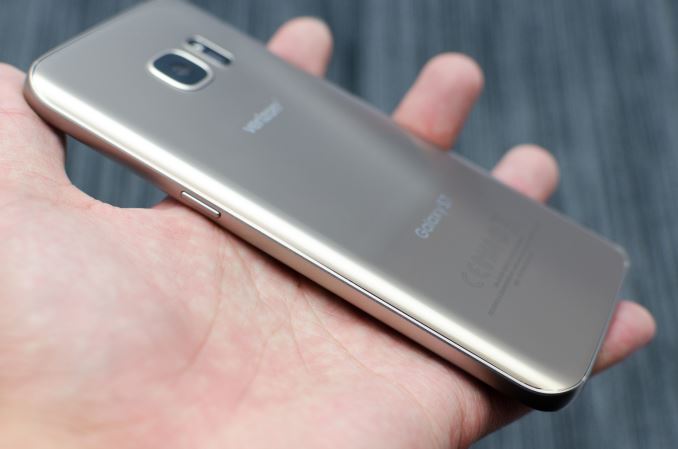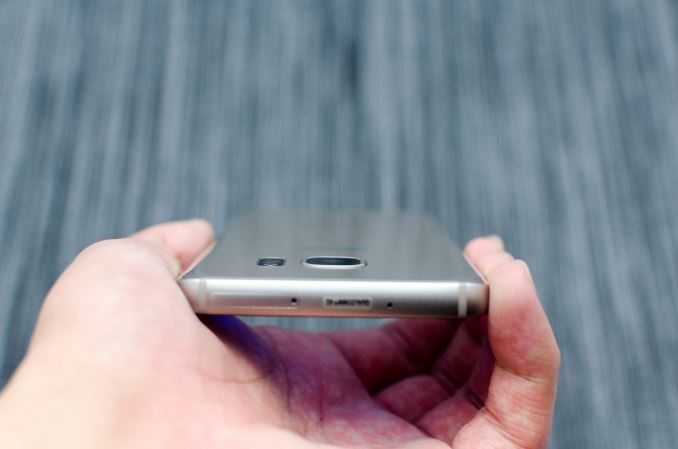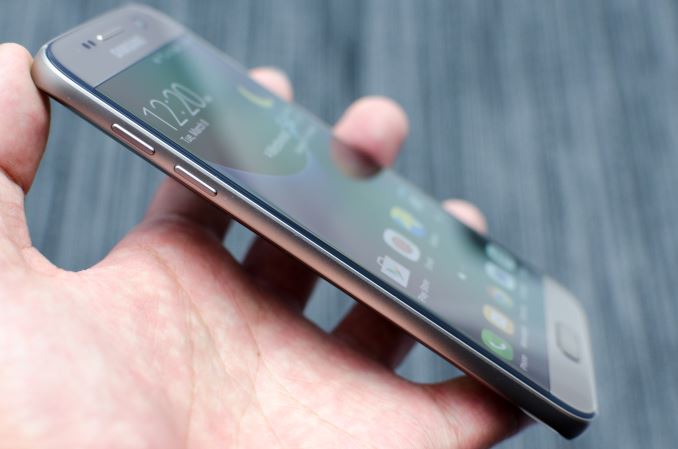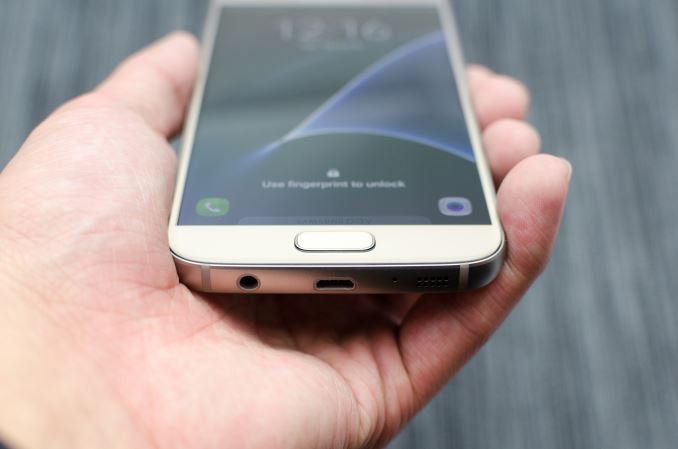The Samsung Galaxy S7 & S7 Edge Review, Part 1
by Joshua Ho on March 8, 2016 9:00 AM EST
For some time now, Samsung has been the dominant player in the Android space, especially at the high end of the market. From the Galaxy S2 onwards, Samsung has been able to ride the wave of the smartphone industry’s growth without much disruption. Samsung has also shown a pretty impressive ability to adapt to changes in the market as seen by their dramatic departure in materials from the Galaxy S5 generation to the Galaxy S6 generation. While the Galaxy S6 was ultimately one of the best phones you could get that year, at least a few design decisions like the loss of removable battery and microSD slot were generally considered to be a step back relative to previous devices.
Throughout their reign of dominance Samsung has always been able to stay on top, however their competition is never too far behind. To that end, it’s probably obvious now that the Galaxy S7 family represents an attempt to improve on the Galaxy S6’s perceived faults, while building upon its perceived strengths. In order to start discussing these changes, we can start by looking at the basic specs and design of the Galaxy S7 and S7 edge.
| Samsung Galaxy S Family | |||||
| Samsung Galaxy S7 | Samsung Galaxy S7 edge | Samsung Galaxy S6 | Samsung Galaxy S6 edge | ||
| SoC | Snapdragon 820 (US, China, Japan) 2x Kryo @ 2.15GHz 2x Kryo @ 1.6GHz Adreno 530 Exynos 8890 (Rest of World) 4x A53 @ 1.58GHz 4x Exynos M1 @ 2.28-2.60GHz Mali T880MP12 @ 650MHz |
Exynos 7420 4x Cortex-A57 @ 2.1GHz 4x Cortex-A53 @ 1.5GHz Mali T760MP8 |
|||
| RAM | 4GB LPDDR4-3600 | 3GB LPDDR4-3100 | |||
| NAND | 32/64GB NAND (UFS) + microSD |
32/64/128GB NAND (UFS) | |||
| Display | 5.1” 1440p SAMOLED |
5.5" 1440p SAMOLED Dual Edge |
5.1” 1440p SAMOLED |
5.1” 1440p SAMOLED Dual Edge |
|
| Network | S820: Qualcomm X12 Integrated 2G / 3G / 4G LTE (Category 12/13) |
2G / 3G / 4G LTE (Category 6) | |||
| Dimensions | 142.4 x 69.6 x 7.9 mm, 152 grams | 150.9 x 72.6 x 7.7 mm, 157 grams | 143.4 x 70.5 x 6.8mm max, 138 grams | 142.1 x 70.1 x 7.0mm max, 132 grams | |
| Camera | Rear Camera w/OIS 12MP (4032 x 3024) Sony IMX260 f/1.7, object tracking AF |
Rear Camera w/OIS 16MP (5132 x 2988) Sony IMX240 / Samsung S5K2P2 f/1.9, object tracking AF |
|||
| Front Facing 5MP, f/1.7 |
Front Facing 5MP , f/1.9 |
||||
| Battery | 3000mAh (11.55 WHr) | 3600mAh (13.86 WHr) | 2550 mAh (9.81 WHr) | 2600 mAh (10.01 WHr) | |
| Launch OS | Android 6 w/TouchWiz | Android 5 w/TouchWiz | |||
| Connectivity | 802.11a/b/g/n/ac 2x2 MU-MIMO + BT 4.2, USB2.0, GPS/GNSS, NFC |
2x2 802.11a/b/g/n/ac + BT 4.1 (BCM4358), USB2.0, GPS/GNSS, NFC |
|||
| Wireless Charging | Yes, Fast Charging | WPC 1.1 (4.6W) & PMA 1.0 (4.2W) |
|||
| Fingerprint Sensor | Touch | Touch | |||
| SIM Size | NanoSIM | NanoSIM | |||
| Launch Price (No Contract) |
$650+ USD | $750+ USD | $650+ USD |
$750+ USD |
|
One of the other major changes in terms of design this time around is electing to go with a significantly larger battery than before. Compared to most other aspects of smartphone technology, battery technology is a more mature field and improves as a slower pace, so the tradeoffs made here result in a thicker device and increased weight relative to the Galaxy S6. However, as we’ll soon see Samsung has made a number of changes in the industrial design which help to mitigate these issues.
Meanwhile, with the Galaxy S7 generation, Samsung has further blurred the line between the Galaxy S lineup and the Galaxy note. The Galaxy S7 edge is a 5.5-inch device - fully into the phablet territory - and only 0.2 inches smaller than the 5.7" Galaxy Note5. This means that the two Galaxy S7 phones are now more significantly differentiated than with the Galaxy S6 generation, where the difference amounted to the dual-edge display and a slightly larger battery. Now the Galaxy S7 edge is larger, ever so slightly heavier, and contains a battery with 20% more capacity than it's base Galaxy S7 brethren.
The final change of note in the Galaxy S7/S7 edge is the camera. With the Galaxy S6 review it was hard to avoid wondering why Samsung didn’t bother to integrate a camera with larger pixel size to improve low light performance, especially when camera was such a significant part of the Galaxy S6 design story with the noticeable camera hump. For the Galaxy S7, Samsung has gone ahead and done just this: the pixel size is now 1.4 micron which should significantly increase the number of situations where the image quality is limited by shot noise rather than image sensor noise. And to top things off the camera hump has now been almost entirely eliminated.
On a quick housekeeping note before we dive in, as we've had less than a week to look at the Galaxy S7, we're dividing up our review into two parts. Today we'll focus on the basics: performance, battery life, design, and the display. Part 2 will go deeper, looking into the Snapdragon 820 SoC in fuller detail, and coupling that with Wi-Fi performance, camera performance, and more.
Design
Now that we’ve gone over the high level changes of the Galaxy S7 and S7 edge, we can start talking about the design of the device. While the Galaxy S6 was an enormous departure from what we were used to seeing from Samsung, the Galaxy S7 is really more an evolution of the Galaxy S6 design. As previously mentioned, it is noticeably thicker and heavier than the Galaxy S6. However, to offset this increase in thickness Samsung has integrated the curved 3D glass of the Galaxy Note5 into the design of the Galaxy S7.
The result of this change is that the Galaxy S7 arguably feels much better in the hand than the Galaxy S6. While I didn’t really have huge issues with the ergonomics of the Galaxy S6, it definitely felt a bit blocky relative to something like the Xiaomi Mi Note Pro and didn’t quite fit in the hand as nicely. The weight increase is noticeable, but not really the end of the world.
The thickness does result in a noticeably reduced camera hump, but on a personal level I never really cared about the camera hump in the Galaxy S6, so I’m not sure I care about the reduction in the camera hump here. I would actually argue that a camera hump is preferable to a camera cover lens that is perfectly coplanar to the back of the phone, as it means that the camera lens isn’t contacting whatever surface I’ve set it down on. While sapphire cover lenses go a very long way to eliminating the potential for scratching a cover lens, there’s also the potential for oil to smear on the camera’s cover lens so I would actually prefer having a camera hump.
The other noticeable change here is the re-introduction of 2.5D curved glass on the edges of the display. I’m not quite sure why Samsung tends to remove and re-introduce this design element seemingly on and off, but it does help with improving the feel of edge swipes at the cost of complicating some things like screen protectors and glass lens durability. Honestly speaking, I’m not sure how much of a difference it makes either way, but it does remove another edge present in the design.
Other than these changes, the design is almost unchanged. The power button remains on the right side of the device and is well-positioned ergonomically. The volume buttons are pretty much in the same place on the left side as well. The 3.5mm jack, micro-USB port, and single speaker are all on the bottom of the device. The only notable deletion in terms of design elements here would be the loss of the IR port on top of the device, which was removed from Galaxy devices starting with the Note5.














202 Comments
View All Comments
jjj - Tuesday, March 8, 2016 - link
As for battery tests, as long as you don't simulate a bunch of social, IM, news apps in the backgroud, you can't get close to good results when you got so many diff core configs.retrospooty - Tuesday, March 8, 2016 - link
"s long as you don't simulate a bunch of social, IM, news apps in the backgroud, you can't get close to good results when you got so many diff core configs"You have to have consistent methodology to test against other phones. The point is not to show what you might get with your particular social/newsfeed apps running, the point is to test against other phones to see how it compares under the same set of circumstances so you know which one gets better life.
jjj - Tuesday, March 8, 2016 - link
Sorry but you failed to understand my points.It would be consistent ,if it is simulated.
The point is to have relatively relevant data and only by including at least that you can get such data. These apps have major impact on battery life- and it's not just FB even if they were the only ones that got a lot of bad press recently.
The different core configs - 2 big cores, 4 big cores in 2+2, then 4+4, 2+4+4, or just 8 will result in very different power usage for these background apps, as a % of total battery life, sometimes changing the rankings. Here for example, chances are the Exynos would get a significant boost vs the SD820 if such tasks were factored in.
How many such simulated tasks should be included in the test is debatable and also depends on the audience, chances are that the AT reader has a few on average.
retrospooty - Tuesday, March 8, 2016 - link
And you are missing mine as well... If you have a million users, you will have 10,000 different sets of apps. You cant just randomly pick and call it a benchmark. The methodology and the point it to measure a simple test against other phones without adding too many variables. I get what you want, but its a bit like saying "i wish your test suite tested my exact configuration" and that just isnt logical from a test perspective.jjj - Tuesday, March 8, 2016 - link
What i want is results with some relevance.The results have no relevance as they are, as actual usage is significantly different. In actual usage the rankings change because the core configs are so different. The difference is like what VW had in testing vs road conditions, huge difference.
To obtain relevant results you need somewhat realistic scenarios with a methodology that doesn't ignore big things that can turn the rankings upside down. Remember that the entire point of bigLITTLE is power and these background tasks are just the right thing for the little cores.
retrospooty - Tuesday, March 8, 2016 - link
relevant to who? I use zero social media apps and have no news feeds running at all until I launch feedly. Relevant to you is not relevant to everyone or even to most people. This site is a fairly high traffic site (for tech anyhow) and they have to test for the many, not the few. The methodology is sound. I see what you want and why you want it, but it doesn't work for "the many"jjj - Tuesday, March 8, 2016 - link
Relevant to the average user. I don't use social at all but that has no relevance as the tests should be relevant to the bulk of the users. And the bulk of the users do use those (that's a verifiable fact) and more. This methodology just favors fewer cores and penalizes bigLITTLE.retrospooty - Tuesday, March 8, 2016 - link
Its still too unpredictable. One persons Facebook feed may go nuts all day while anothers is relatively calm. This is also why specific battery ratings are never given by manufacturers... Because usage varies too much. This is why sites test a (mostly) controllable methodology against other phones to see which fares the best. I find it highly useful and when you get into the nuts and bolts, it's necessary. If you had a bunch of phones and actually started trying to test as you mentioned you would find a can of worms and inconsistent results at the end of your work...jjj - Wednesday, March 9, 2016 - link
"Its still too unpredictable" - that's the case with browsing usage too, even more so there but you can try to select a load that is representative. You might have forgotten that i said simulate such apps, there wouldn't be any difference between runs.Yes testing battery life is complex and there are a bunch of other things that could be done for better results but these apps are pretty universal and a rather big drain on resources.They could be ignored if we didn't had so many core configs but we do and that matters. Complexity for the sake of it is not a good idea but complexity that results in much better results is not something we should be afraid of.
10 years later smartphone benchmarking is just terrible. All synthetic and many of those apps are not even half decent. Even worse, after last year's mess 99% of reviews made no attempt to look at throttling. That wouldn't have happened in PC even 10 years ago.
retrospooty - Wednesday, March 9, 2016 - link
I think you are a little too hung up on benchmarks. It is just a sampling, an attempt at measuring with the goal to compare to others to help people decide, but what really matters is what it does and how well it does it. I find it highly useful even if not exact to my own usage. If unit A lasts 20 hours and unit B lasts 16 hours in the standard tests, but I know my own usage gets 80% of what standard is I can estimate my usage will be 16 hours on unit A and 12.8 hours on unit B (give or take). It really doesn't need to be more complicated than that since testing batteries is not an exact science, not even on PC/laptops as usage varies there just hte same. That is why there are no exact guarantees. "Up to X hours" is a standard explanation. It is what it is.